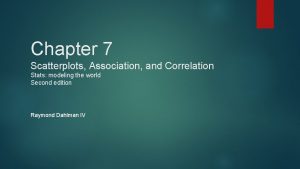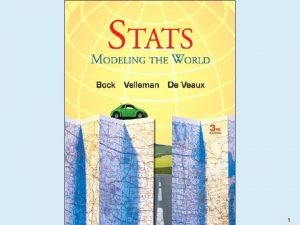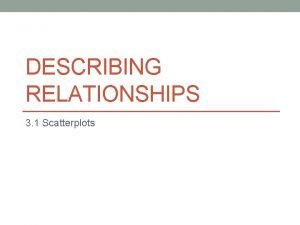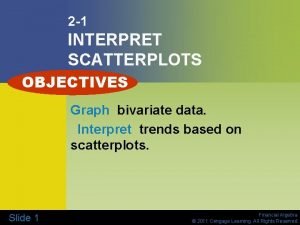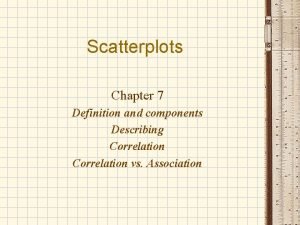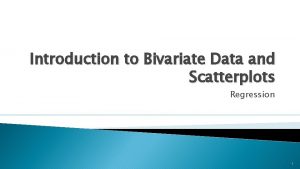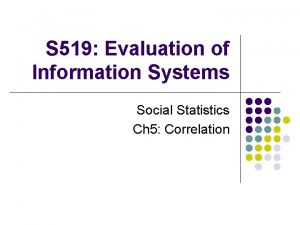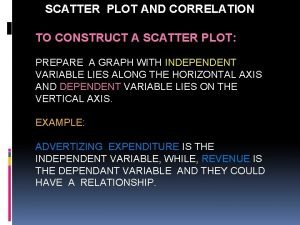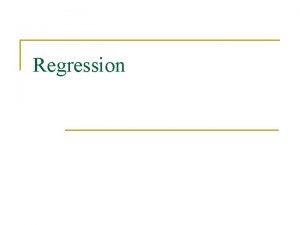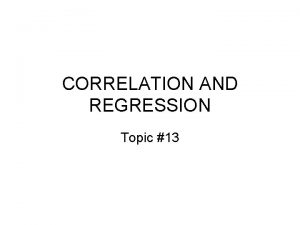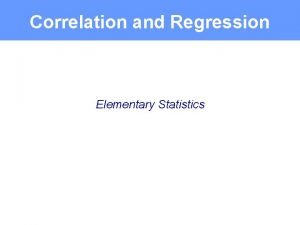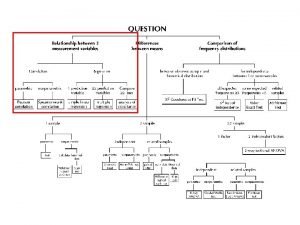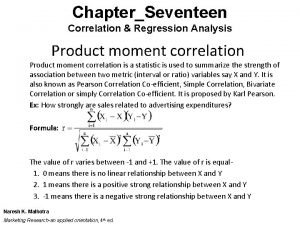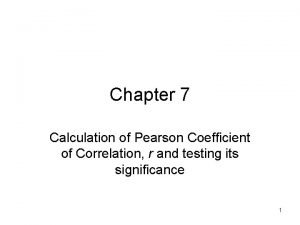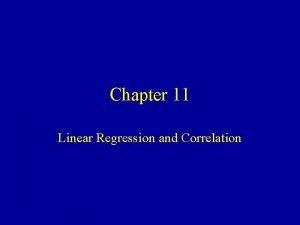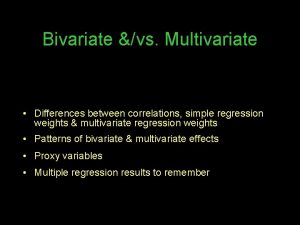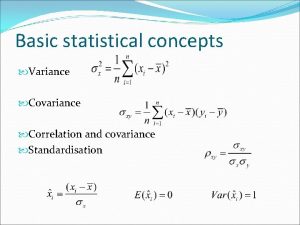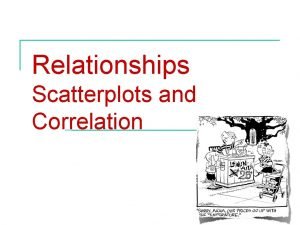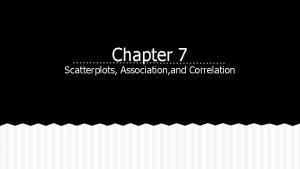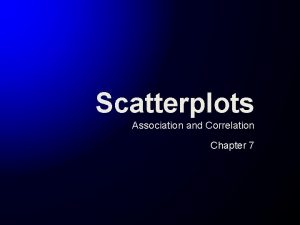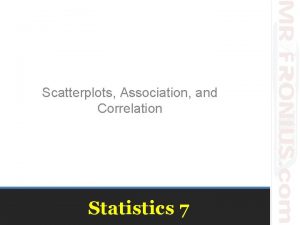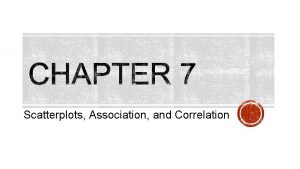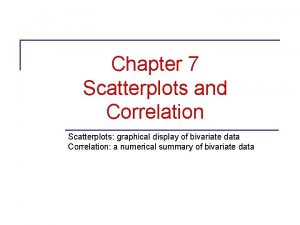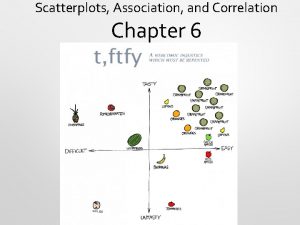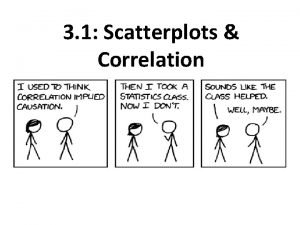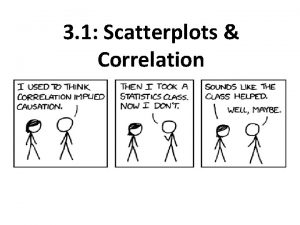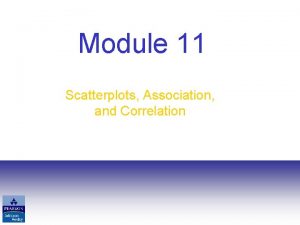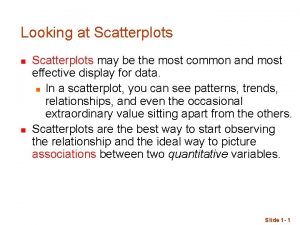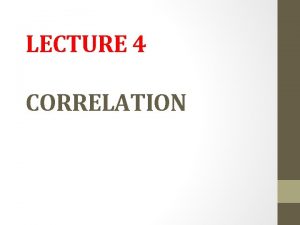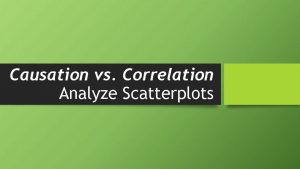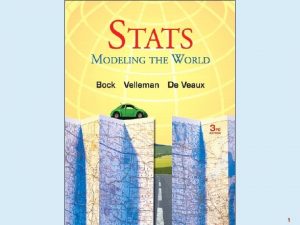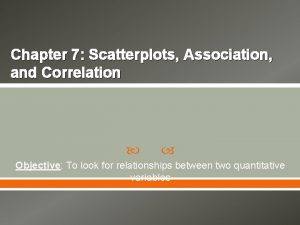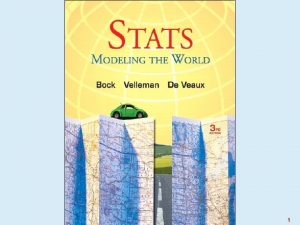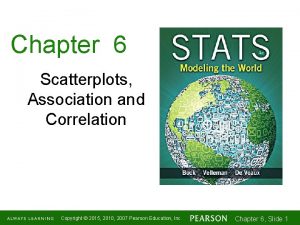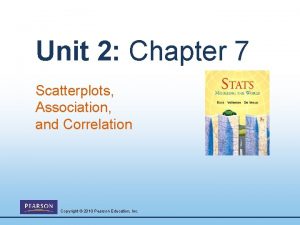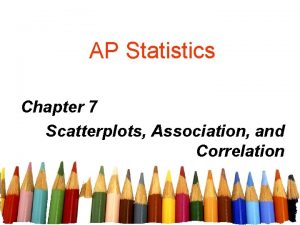Chapter 7 Scatterplots Association and Correlation Looking at


























- Slides: 26

Chapter 7 Scatterplots, Association, and Correlation

Looking at Scatterplots l Scatterplots may be the most common and most effective display for data. – l In a scatterplot, you can see patterns, trends, relationships, and even the occasional extraordinary value sitting apart from the others. Scatterplots are the best way to start observing the relationship and the ideal way to picture associations between two quantitative variables.

Looking at Scatterplots (cont. ) l l When looking at scatterplots, we will look for direction, form, strength, and unusual features. Direction: – – A pattern that runs from the upper left to the lower right is said to have a negative direction. A trend running the other way has a positive direction.

Looking at Scatterplots (cont. ) l Form: – If there is a straight line (linear) relationship, it will appear as a cloud or swarm of points stretched out in a generally consistent, straight form.

Looking at Scatterplots (cont. ) l Form: – If the relationship isn’t straight, but curves gently, while still increasing or decreasing steadily, we can often find ways to make it more nearly straight.

Looking at Scatterplots (cont. ) l Strength: – At one extreme, the points appear to follow a single stream (whether straight, curved, or bending all over the place).

Looking at Scatterplots (cont. ) l Strength: – At the other extreme, the points appear as a vague cloud with no discernable trend or pattern: – Note: we will quantify the amount of scatter soon.

Looking at Scatterplots (cont. ) l Unusual features: – – – Look for the unexpected. One example of such a surprise is an outlier standing away from the overall pattern of the scatterplot. Clusters or subgroups should also raise questions.

Roles for Variables l l l It is important to determine which of the two variables goes on the x-axis and which on the y-axis. When the roles are clear, the explanatory or predictor variable goes on the x-axis, and the response variable goes on the y-axis. Just placing a variable on the x-axis doesn’t necessarily mean that it explains or predicts anything. And the variable on the y-axis may not respond to it in any way.

Correlation l l Data collected from students in Statistics classes included their heights (in inches) and weights (in pounds): Here we see a positive association and a fairly straight form, although there seems to be a high outlier.

Correlation (cont. ) l l l How strong is the association between weight and height of Statistics students? If we had to put a number on the strength, we would not want it to depend on the units we used. A scatterplot of heights (in centimeters) and weights (in kilograms) doesn’t change the shape of the pattern:

Correlation (cont. ) l The correlation coefficient (r) gives us a numerical measurement of the strength of the linear relationship between the explanatory and response variables.

Correlation Conditions l l Correlation measures the strength of the linear association between two quantitative variables. Before you use correlation, you must check several conditions: – – – Quantitative Variables Condition Straight Enough Condition Outlier Condition

Correlation Conditions (cont. ) l Quantitative Variables Condition: – – – Correlation applies only to quantitative variables. Don’t apply correlation to categorical data masquerading as quantitative. Check that you know the variables’ units and what they measure.

Correlation Conditions (cont. ) l Straight Enough Condition: – – You can calculate a correlation coefficient for any pair of variables. But correlation measures the strength only of the linear association, and will be misleading if the relationship is not linear.

Correlation Conditions (cont. ) l Outlier Condition: – – Outliers can distort the correlation dramatically. An outlier can make an otherwise small correlation look big or hide a large correlation. It can even give an otherwise positive association a negative correlation coefficient (and vice versa). When you see an outlier, it’s often a good idea to report the correlations with and without the point.

Assignment A#3/7 p. 160 #2, 5, 7, 9, 11, 15

Correlation Properties l l The sign of a correlation coefficient gives the direction of the association. Correlation is always between -1 and +1. – – Correlation can be exactly equal to -1 or +1, but these values are unusual in real data because they mean that all the data points fall exactly on a single straight line. A correlation near zero corresponds to a weak linear association.

Correlation Properties (cont. ) l Correlation treats x and y symmetrically: – l l The correlation of x with y is the same as the correlation of y with x. Correlation has no units. Correlation is not affected by changes in the center or scale of either variable. – Correlation depends only on the z-scores, and they are unaffected by changes in center or scale.

Correlation Properties (cont. ) l Correlation measures the strength of the linear association between the two variables. – l Variables can have a strong association but still have a small correlation if the association isn’t linear. Correlation is sensitive to outliers. A single outlying value can make a small correlation large or make a large one small.

What Can Go Wrong? l Don’t say “correlation” when you mean “association. ” – – More often than not, people say correlation when they mean association. The word “correlation” should be reserved for measuring the strength and direction of the linear relationship between two quantitative variables.

What Can Go Wrong? (cont. ) l Don’t correlate categorical variables. – l Be sure to check the Quantitative Variables Condition. Be sure the association is linear. – There may be a strong association between two variables that have a nonlinear association.

What Can Go Wrong? (cont. ) l Beware of outliers. – – Even a single outlier can dominate the correlation value. Make sure to check the Outlier Condition.

What Can Go Wrong? (cont. ) l Don’t confuse correlation with causation. – Not every relationship is one of cause and effect.

What Can Go Wrong? (cont. ) l Watch out for lurking variables. – A hidden variable that stands behind a relationship and determines it by simultaneously affecting the other two variables is called a lurking variable.

Assignment A#3/8 p. 164 #22, 25, 29
 Chapter 7 scatterplots association and correlation
Chapter 7 scatterplots association and correlation Chapter 7 scatterplots association and correlation
Chapter 7 scatterplots association and correlation Impressions examples
Impressions examples Looking out looking in chapter 9
Looking out looking in chapter 9 Positive vs negative correlation
Positive vs negative correlation Positive correlation versus negative correlation
Positive correlation versus negative correlation Describing scatterplots
Describing scatterplots 2-1 interpret scatterplots answer key
2-1 interpret scatterplots answer key Scatterplots definition
Scatterplots definition Introduction to bivariate data
Introduction to bivariate data Correlation vs association
Correlation vs association Correlation vs association
Correlation vs association Duns and ros correlation
Duns and ros correlation Eq and iq correlation
Eq and iq correlation Correlation in scatter diagram
Correlation in scatter diagram Difference between regression and correlation
Difference between regression and correlation Shoe size and height data
Shoe size and height data Correlation types and methods
Correlation types and methods Correlation and regression
Correlation and regression 230-220 x 1/2
230-220 x 1/2 Difference between regression and correlation
Difference between regression and correlation Difference between regression and correlation
Difference between regression and correlation Ssxx equation
Ssxx equation How to calculate sst in regression
How to calculate sst in regression Absolute value of correlation coefficient
Absolute value of correlation coefficient Multivariate vs bivariate
Multivariate vs bivariate Variance and covariance
Variance and covariance
